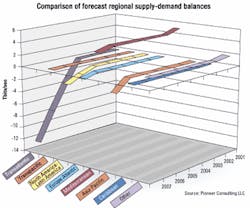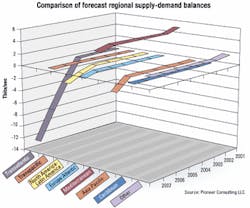New transatlantic cable operators afloat in steady sea of demand
By KATHLEEN RICHARDS
Like the rest of the telecommunications sector, the undersea segment is facing oversupply issues, bandwidth-price erosion, sharply reduced investment levels, and market volatility. By 2003, only 14% of total submarine capacity is expected to be lit and generating revenue, according to market researcher Pioneer Consulting LLC (Boston).
The transatlantic market, however, is one of the bright spots. As multiple transatlantic cables come into service- consortium cable TAT-14 in May, FLAG Atlantic-1 and TyCom Transatlantic in June-demand in this market is robust. Between 2000 and 2007, Pioneer is forecasting 83% compound annual growth in transatlantic demand (including Europe to South America) for submarine cable capacity. The 360Atlantic-1 cable was also completed in May, but plans for the cable remain unclear. 360networks filed for bankruptcy protection in June. Table 1 shows the transatlantic cables commissioned or upgraded since 1999.
"Transatlantic is the one market where we are not seeing huge oversupply at the moment," says Julian Rawle, senior market analyst at Pioneer Consulting. "There is growing demand, and the supply is a little ahead of the demand, but not seriously. We're projecting the next cable for transatlantic will be required in 2004, which is much earlier than any of the other major routes."
Based on forecast demand versus supply for the transatlantic route between 2003 and 2007, Pioneer expects a requirement for four new transatlantic systems, each of which is likely to have a total system capacity of 10 Tbits/sec. That is in addition to capacity upgrades to existing systems of about 4.5 Tbits/sec (see Figure).
"For the transatlantic market, I think everybody at the moment is focused on who is offering the cheapest bandwidth," says Rawle, "and you need to have one of the latest generation cables in order to offer the lowest cost-you need to have a terabit cable, basically. So there isn't a lot to choose between those five cables-360Atlantic, Flag Atlantic, TAT-14, TyCom, and Apollo." The Cable & Wireless Apollo cable, scheduled to be ready for service in September 2002, is designed to carry only IP traffic. The other four cables will transmit both voice and IP traffic.
TyCom Transatlantic cable, part of TyCom Ltd.'s planned global network, is a four-fiber ring system capable of carrying 64 fully protected 10-Gbit/sec wavelengths, the equivalent of 2.56 Tbits. It connects New York to London, Paris, Frankfurt, and Amsterdam.
"We actually turned up the capacity in advance of what we originally contemplated," says Brian Roussell, vice president of global sales and marketing at TyCom (Pembroke, Bermuda). "We were able to deploy the system sooner, and we also had demand for that capacity in our third quarter [second quarter for the calendar year], so we turned up capacity at the end of June and we're lighting additional capacity now." TyCom is targeting Tier 1, 2, and 3 carriers as well as Internet service providers. Services range from clear channel wavelengths to protected STM-64s (9.953 Gbits/sec) to STM-1s (51.84 Mbits/sec). Capacity is sold on an indefeasible right of use as well as on a leasing basis. About 10% of the cable's capacity is expected to be sold by the end of the company's fiscal year at the end of this month."When a lot of new capacity came online and some of the other providers of subsea capacity were out there trying to generate sales and to generate cash to support their balance sheet and debt load, there were some significant price drops," says Roussell. "We have seen fairly recently that the pricing has actually begun to stabilize; certainly the erosion rate has slowed down considerably."
TyCom's strategy is to build a global network that upon completion of phase 1 will link the Atlantic, Pacific, Mediterranean, intra-Asia, and India. This "vertical integration strategy" will enable the network operator to be the low-cost provider of capacity in the Atlantic, and eventually around the world, asserts Roussell. "Because of that we can weather the price-erosion storm reasonably well and still generate the type of margins that we were hoping to generate as part of our business plan," he says.
The TAT-14 consortium cable, ready for service in May, faces other marketing issues. Paid for by 49 investors with $1.4 billion to recoup, the cable connects the U.S. to the U.K., France, the Netherlands, Germany, and Denmark. Concert, a global joint venture between AT&T and British Telecom, is the largest investor. The cable was designed to carry 1.3 Tbits/sec of protected capacity.
"We have carriers' requirements, but the deals are not completed yet," says Sheel Manchanda, director of international cable management at Concert and the American co-chairman of the consortium. "Initially we had thought that within two years, the system would be used up," says Manchanda, who expects at least 60% of the capacity to be turned up by the end of the year.
"We see quality of service coming back into play in customers' bandwidth purchasing decisions," says Pioneer's Rawle, "and we see transatlantic being the first market where this is going to start happening, simply because bandwidth prices have fallen so far that there isn't a lot of scope to go much lower, certainly with the current technology. We think that MPLS is a technology which will enable carriers to differentiate their bandwidth by offering different levels of service-meaning routing it in different ways, offering different speeds-and we think that MPLS is going to play a part in the development of the transatlantic market over the next three years."

